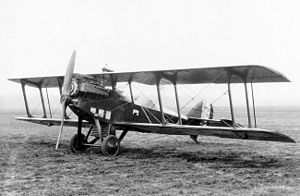Packard-Le Père LUSAC-11
| LUSAC-11 | |
|---|---|

| |
| The LUSAC-11 which broke the World altitude record in 1928 | |
| Role | Fighter aircraft |
| National origin | United States of America |
| Manufacturer | Engineering Division/Packard |
| Designer | Georges Lepère |
| First flight | 15 May 1918 |
| Primary user | United States Army Air Service |
| Number built | 30 |
| Developed into | Waterman 3-L-400 |
The LUSAC-11 (Lepère United States Army Combat) was an early American Army two-seat fighter aircraft. It was designed during World War I and ordered in large numbers, but these were cancelled at the enhd of the war, and only 30 were built. The type was used for experimental purposes, setting several altitude records during the 1920s.
Design and development
When the U.S. entered World War I, the Signal Corps had just 55 aircraft,[1] none fit for combat. The American Expeditionary Force was equipped with French types,[1] and the LUSAC was part of a plan to build French designs in the U.S.
Georges Lepère,[2] a member of the French Aeronautical Mission to the United States, was tasked by the Engineering Division of the United States Army Air Service to design a two-seat escort fighter.[3] His design was a two-bay biplane with upper and lower wings of equal span with forward stagger. It was of wood and fabric construction, with the fuselage consisting of a wooden box girder with plywood covering. It was powered by a 425 hp (317 kW) Liberty L-12 engine cooled by a radiator faired into the upper wing. Armament was two .30 inch (7.62 mm) machine guns synchronized to fire through the propeller, with two Lewis guns flexibly mounted on a Scarff ring at the observer's cockpit.[4]
Large orders for the new design were placed, with Packard, Brewster & Co. and the Fisher Body Corporation, a total of 3,525 ordered. The first prototype made its maiden flight at McCook Field, Dayton, Ohio on 15 May 1918. Despite a forced landing due to fuel starvation on its first flight, testing proved successful, with speeds of 136 mph (219 km/h) being reached.[5] Only thirty were completed by the Armistice, the rest being cancelled.
Three additional aircraft were completed with 420 hp (317 kW) Bugatti 16 engines as LUSAC-21s. These were delivered in August 1919.
In addition, three strafer aircraft were built, as LUSAGH (Le Peré United States Army Ground Harassment), two with Bugatti engines (LUSAGH-21), one a Liberty (LUSAGH-11).
One LUSAC-11, fitted with a turbocharged Liberty, was flown to a record height of 34,507' (10,518 m) on 28 September 1921 by Lieutenant John A. Macready, for which he won the Mackay Trophy. The record held two years.

There was also an experimental LUSAC-11 triplane, the LUSAO-11 (Le Pere United States Army Observation), which used two Liberty L-12As.
Operators
Specifications (LUSAC-11)
Data from The American Fighter[3]
General characteristics
- Crew: 2 (pilot & observer/gunner)
Performance
- Climb to 6,500 ft (1,980 m): 6 min
Armament
- Guns: [6]
- 2×.30 in (7.62mm) Marlin machine guns on the upper fuselage
- 2×.30 in (7.62mm) Lewis guns in the observer's cockpit
References
- Angelucci, Enzo and Peter M. Bowers. The American Fighter. Sparkford, UK:Haynes Publishing Group, 1987. ISBN 0-85429-635-2.
- Fitzsimons, Bernard, ed. "LUSAC-11, Packard-Le Peré". Illustrated Encyclopedia of 20th Century Weapons and Warfare. Volume 16, p.1782-3. London: Phoebus, 1978.
- Owers, Colin. "Stop-Gap Fighter:The LUSAC Series". Air Enthusiast, Fifty, May to July 1993. Stamford, UK:Key Publishing. ISSN 0143-5450. pp. 49–51.
